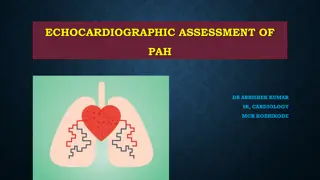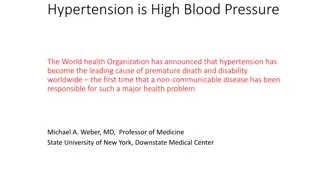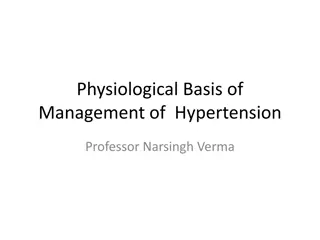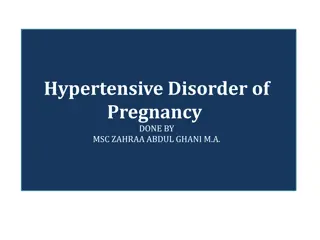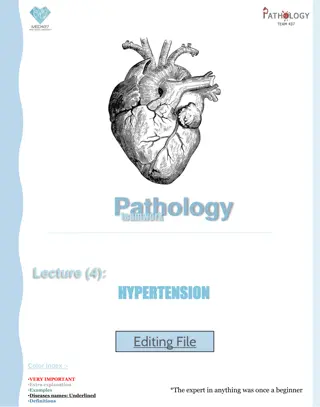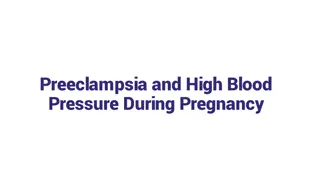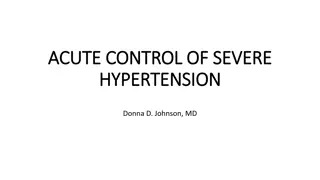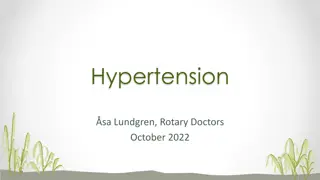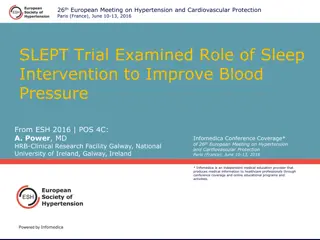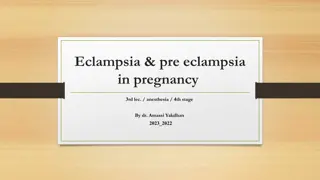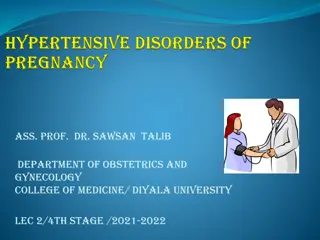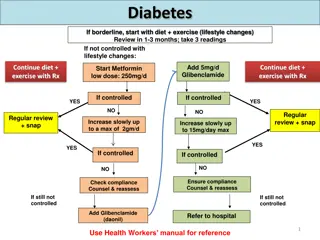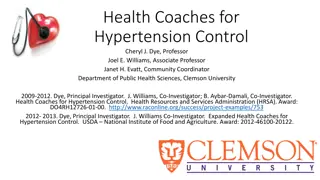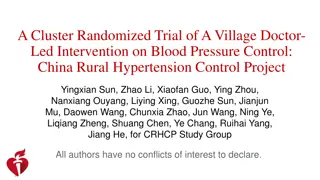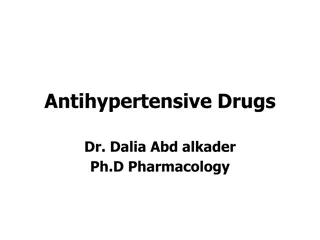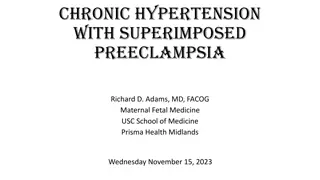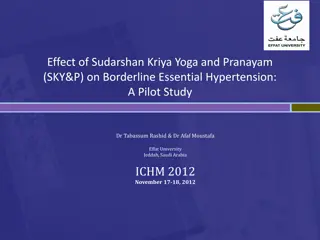Hypertension Diagnosis and Management in a Case Study
Mrs. Esraa, a 41-year-old architect, presents for a follow-up in a clinic. Despite being euthyroid and generally fit, her blood pressure is high at 146/88 mmHg. Proper blood pressure measurement is emphasized, along with considerations for diagnosing hypertension and initiating treatment. The discussion also covers different stages of hypertension based on clinic and subsequent ambulatory or home blood pressure monitoring.
Download Presentation

Please find below an Image/Link to download the presentation.
The content on the website is provided AS IS for your information and personal use only. It may not be sold, licensed, or shared on other websites without obtaining consent from the author. Download presentation by click this link. If you encounter any issues during the download, it is possible that the publisher has removed the file from their server.
E N D
Presentation Transcript
Hypertension scenario cases FM review course 2019 Dr. Dalia Alsanea Consultant Family Medicine Head of Surra Clinic, Capital Health District, M.O.H Trainer & Examiner at FMRP, KIMS Head of OSCE exam committee, FMRP
Case 1 Mrs. Esraa
Case 1 Presentation Mrs. Esraa is a fit 41-year-old Kuwaiti, architect in private office. Today came to the clinic for follow-up in CD clinic for hypothyroid. Clinically she is euthyroid, Last TFT normal 3/2019. There are no other medical illnesses. She never smoke.
Case 1 Physical exam: Height of 154 cm, weight of 67 Kg, BMI 28.3 Blood pressure of 146/88 mmHg, and a regular pulse of 76 beats/min.
Case 1 What is next? 1. Not known to have hypertension. 2. Last BP recorded in the file 120/70 mmHg (12/2017) What is next? Proper checking, how?
Case 1 Proper BP measuring is ensured. The next Q is ? Is she hypertensive?
Case 1 When considering a diagnosis of hypertension, measure BP in both arms. If the difference in readings between arms is >20 mmHg, repeat the measurements. If the difference in readings remains >20 mmHg, measure subsequent blood pressures in the arm with the higher reading. If BP measured in the clinic 140/90 mmHg: Take a second measurement during the consultation. If the second measurement is substantially different from the first, take a third measurement. Record the lower of the last two measurements as the clinic BP.
Case 1 Mrs Esraa 2nd BP reading with proper measuring method is 144/90, no difference between both arms. What to do next? A. Initiate low dose anti-HTN therapy B. Initiate high dose anti-HTN therapy C. Reassure the patient D. Arrange for further assessment E. Annual follow-up for clinic BP
Which stage of htn Stage 1 hypertension Clinic BP 140/90 mmHg and subsequent ABPM daytime average or HBPM average 135/85 mmHg. Clinic BP 160/100 mmHg and subsequent ABPM daytime average or HBPM average 150/95 mmHg. Clinic systolic BP 180 mmHg or clinic diastolic BP 110 mmHg. Stage 2 hypertension Severe hypertension
Diagnosing hypertension If the clinic BP 140/90 mmHg, offer ambulatory blood pressure monitoring (ABPM) to confirm the diagnosis of hypertension. If a person is unable to tolerate ABPM, home blood pressure monitoring (HBPM) is a suitable alternative. If the person has severe hypertension, consider starting antihypertensive drug treatment immediately, without waiting for the results of ABPM or HBPM.
Case 1 You were unable to confirm the diagnosis with ABPM because she refused it because as it would interfere with her daily activities. What alternative test could you have used to diagnose hypertension? A. Home blood pressure monitoring (HBPM). B. Daily BP checking in the clinic. C. No need to confirm at the mean time. D. Insist to do ABPM. E. A or B
Case 1 Question 2: When instructing Mrs. Esraa in how to use HBPM, what instructions did you have to give her and what measurements would you base your diagnosis on?
HBPM When using HBPM: 2 measurements are taken at least 1 minute apart and BP is recorded twice daily, morning and evening and BP recording continues for at least 4 days, ideally for 7 days. Discard the measurements taken on the first day and use the average value of all the remaining measurements.
Mrs. Hadeel agreed for 1 week HBPM. While waiting to confirm the diagnosis, carry out investigations for target organ damage and a formal assessment of cardiovascular risk. What?
Types of thn Primary HTN: also known as essential HTN. accounts for 95% cases of HTN. no universally established cause known. Secondary HTN: less common cause of HTN ( 5%). secondary to other potentially rectifiable causes (Renal, Endocrine, Vascular, Pregnancy related & Drug induced).
Case 1 What type of hypertension the patient may have, most likely?
Secondary causes of hypertension? For patients <40 years with stage 1 hypertension and no evidence of target organ damage, cardiovascular disease, renal disease or diabetes, consider specialist referral to exclude secondary causes. Specific investigations for a suspected secondary cause: 24-hour urinary metanephrines. Urinary free cortisol and/or dexamethasone suppression test. Renin/aldosterone levels. Plasma calcium. Magnetic resonance imaging of the renal arteries.
Initial visit Confirm the diagnosis of HTN Stage the hypertension Role out 2ry causes Assess end organ damage Assess other CV risk factors Assess CVD 10-year risk Management plan
End organ damage Brain : TIA, stroke, vascular demntia Heart : 1- symptoms of failure or ECG strain 2- angina, MI or other coronary disease Eye : fundal hemorrahge or papilloedema Kidney : protienuria, renal failure Peripheral vascular disease : claudication
Assess 10-yr cv risk Use any validated CV risk assessment tool: ASCVD, Framingham risk assessment, Q risk, UKPDS, . Etc..
Case 1 Question 1: How would you grade her cardiovascular risk level? A. Low risk (<10%) B. Moderate risk (10-20 %) C. High risk (>20%) D. Very high risk E. Not enough given data to calculate it
Case 1 Mrs. Esraa came back in 2 weeks follow-up visit. Her BP today is 148/90, pulse 80. Her recent lab tests: Electrolytes, FBC, lipids, glucose and uric acid tests are normal. Recent ECG was normal too. What do you want to ask for? Average HBPM 144/88
Case 1 Laboratory:
Case 1 What is the best next action? 1. Start anti-HTN therapy 2. Repeat HBPM for 1 week 3. Start lifestyle measures 4. Refer to hospital 5. Annual follow-up
Case 1 What is the best next action? 1. Start anti-HTN therapy 2. Repeat HBPM for 1 week 3. Start lifestyle measures 4. Refer to hospital 5. Annual follow-up
Life style: Patient education and adherence information about benefits of drugs and side effects an annual review of care.
Case 1 After 1 year, the patient came for a visit and she was compliant to lifestyle. Her average HBPM 160/92. BP in clinic is 165/92. You choose to write a prescription, which agent would be your add on choice? A. ACE inhibitor B. Beta blocker C. Calcium channel blocker D. Thiazide diuretic E. Angiotensin II receptor antagonist
Case 1 What would you regard as an appropriate blood pressure response for clinic BP measures? A. < 130/80 mmHg B. < 140/90 mmHg C. 130/80 mmHg to 140/90 mmHg D. 140/80 mmHg to 140/90 mmHg E. > 140/85 mmHg



